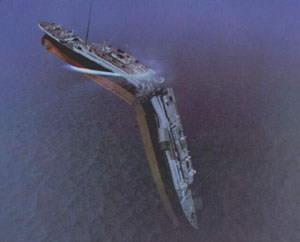Titanic sank faster than it was thought
The breakup and sinking of the Titanic has never been accurately depicted
The research showed that for passengers clinging to life aboard the iceberg-hit Titantic, the fabled final plunge to the ocean floor may have come much faster than previously thought. 
American scientists discovered two large pieces of the Titanic's hull which indicates the liner sank faster than previously thought.
"The breakup and sinking of the Titanic has never been accurately depicted," Parks Stephenson, a Titanic historian, said Monday at a conference at the Woods Hole Oceanographic Institute, where scientists discussed the findings.
Undersea explorer Robert Ballard located the wreck 20 years ago and declared that the ship had broken in two. That is the way the sinking was portrayed in the 1997 film version of the catastrophe.
The two new hull pieces, each about 40 feet by 90 feet, were found this summer by an expedition sponsored by the History Channel.
Previous researchers believed the ship broke in just two major pieces, the bow and stern. David Brown, a Titanic historian, estimated before the latest find that the stern took 20 minutes to slide into the water.
The newly found hull sections, both about 40 feet by 90 feet, were once a single section and were found in good condition, with red bottom paint still visible. The hull pieces were a crucial part of the ship's structure, the researchers said.
After the bottom section of the hull broke free, the bow and stern split, said Roger Long, a naval architect who analyzed the find. The stern, which was still buoyant and filled with survivors, likely plunged toward the North Atlantic floor about five minutes later, the AP reports.
The ocean liner that was billed as "unsinkable" by its owner, struck an iceberg on the maiden voyage and went down in the North Atlantic on April 14, 1912. About 1,500 people died in the shipwreck.
Source: agencies
Subscribe to Pravda.Ru Telegram channel, Facebook, RSS!





